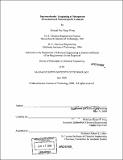| dc.contributor.advisor | Jackie Y. Ying. | en_US |
| dc.contributor.author | Wong, Michael Sha-Nang, 1972- | en_US |
| dc.contributor.other | Massachusetts Institute of Technology. Dept. of Chemical Engineering. | en_US |
| dc.date.accessioned | 2007-11-16T14:36:23Z | |
| dc.date.available | 2007-11-16T14:36:23Z | |
| dc.date.copyright | 2000 | en_US |
| dc.date.issued | 2000 | en_US |
| dc.identifier.uri | http://hdl.handle.net/1721.1/39636 | |
| dc.description | Thesis (Ph.D.)--Massachusetts Institute of Technology, Dept. of Chemical Engineering, 2000. | en_US |
| dc.description | Includes bibliographical references. | en_US |
| dc.description.abstract | Acid catalysis forms the basis of major hydrocarbon reactions in the petroleum industry, including paraffin isomerization, catalytic cracking, and alkylation. The environmental problem associated with the refining of hydrocarbons stems from the corrosive catalysts relied upon by many acid catalytic processes. These catalysts are environmentally dangerous, toxic, hard to handle, and hard to dispose of. Zeolites are well-known as environmentally friendly solid acid catalysts but they suffer from deactivation. Zirconia is of particular interest in acid catalysis because its surface acidic properties can be flexibly tailored. However, the zirconia-based materials typically have low surface areas and poorly controlled textural properties. This thesis reports on the design and synthesis of nanostructured zirconia-based materials through the development of supramolecular templating chemistry. The unique surface and structural properties of these zirconia-based mesoporous materials are related to their activities in solid acid catalysis. The three systems of interest, (i) phosphated zirconia, (ii) zirconia-silica, and (iii) tungstated zirconia, represent mesoporous materials of different acidic strengths and thermal stabilities. The synthesis of mesoporous phosphated zirconia was achieved through the use of alkylphosphate surfactants and zirconium n-propoxide. The surfactant tail groups selforganized via hydrophobic interaction to form micellar cores, around which the alkoxide hydrolyzed and condensed to form an organic-inorganic mesostructure. The phosphate head group reacted with the zirconium alkoxide to form a covalent linkage, which was found necessary for formation of the mesostructure. The phosphate head group allowed the surfactant to be removed without mesostructure collapse and enhanced the thermal stability of the porous phosphated zirconia framework. The phosphate groups also enhanced the surface acidity of zirconia, and mesoporous phosphated zirconia was demonstrated to have moderate acidity. | en_US |
| dc.description.statementofresponsibility | by Michael Sha-Nang Wong. | en_US |
| dc.format.extent | 145 leaves | en_US |
| dc.language.iso | eng | en_US |
| dc.publisher | Massachusetts Institute of Technology | en_US |
| dc.rights | M.I.T. theses are protected by copyright. They may be viewed from this source for any purpose, but reproduction or distribution in any format is prohibited without written permission. See provided URL for inquiries about permission. | en_US |
| dc.rights.uri | http://dspace.mit.edu/handle/1721.1/7582 | |
| dc.subject | Chemical Engineering. | en_US |
| dc.title | Supramolecular templating of mesoporous zirconia-based nanocomposite catalysts | en_US |
| dc.type | Thesis | en_US |
| dc.description.degree | Ph.D. | en_US |
| dc.contributor.department | Massachusetts Institute of Technology. Department of Chemical Engineering | |
| dc.identifier.oclc | 47351255 | en_US |
